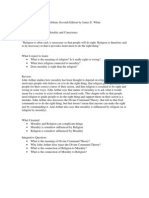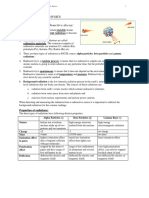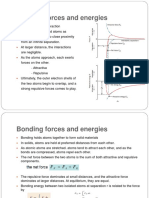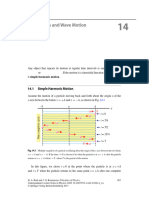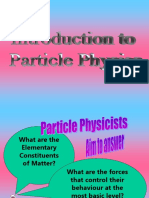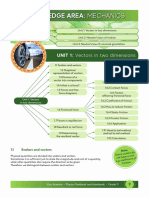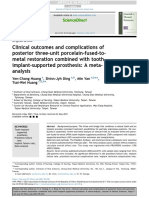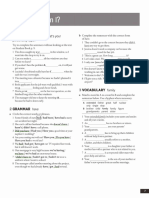List of Particles
List of Particles
Uploaded by
Raghunath HaridasCopyright:
Available Formats
List of Particles
List of Particles
Uploaded by
Raghunath HaridasCopyright
Available Formats
Share this document
Did you find this document useful?
Is this content inappropriate?
Copyright:
Available Formats
List of Particles
List of Particles
Uploaded by
Raghunath HaridasCopyright:
Available Formats
11/3/12
List of particles - Wikipedia, the free encyclopedia
List of particles
From Wikipedia, the free encyclopedia
See also: Timeline of particle discoveries This is a list of the different types of particles found or believed to exist in the whole of the universe. For individual lists of the different particles, see the individual pages given below.
Contents
1 Elementary particles 1.1 Fermions 1.1.1 Quarks 1.1.2 Leptons 1.2 Bosons 1.3 Hypothetical particles 2 Composite particles 2.1 Hadrons 2.1.1 Baryons 2.1.2 Mesons 2.2 Atomic nuclei 2.3 Atoms 2.4 Molecules 3 Condensed matter 4 Other 5 Classification by speed 6 See also 7 References
Elementary particles
Main article: Elementary particle Elementary particles are particles with no measurable internal structure; that is, they are not composed of other particles. They are the fundamental objects of quantum field theory. Many families and sub-families of elementary particles exist. Elementary particles are classified according to their spin. Fermions have half-integer spin while bosons have integer spin. All the particles of the Standard Model have been experimentally observed, recently including the Higgs boson.
Fermions
Main article: Fermion Fermions are one of the two fundamental classes of particles, the other being bosons. Fermion particles are described by FermiDirac statistics and have quantum numbers described by the Pauli exclusion principle. They include the quarks and leptons, as well as any composite particles consisting of an odd number of these, such as all baryons and many atoms and nuclei.
en.wikipedia.org/wiki/List_of_particles#Composite_particles 1/9
11/3/12
List of particles - Wikipedia, the free encyclopedia
Fermions have half-integer spin; for all known elementary fermions this is 12. All known fermions are also Dirac fermions; that is, each known fermion has its own distinct antiparticle. It is not known whether the neutrino is a Dirac fermion or a Majorana fermion.[1] Fermions are the basic building blocks of all matter. They are classified according to whether they interact via the color force or not. In the Standard Model, there are 12 types of elementary fermions: six quarks and six leptons. Quarks Main article: Quark Quarks are the fundamental constituents of hadrons and interact via the strong interaction. Quarks are the only known carriers of fractional charge, but because they combine in groups of three (baryons) or in groups of two with antiquarks (mesons), only integer charge is observed in nature. Their respective antiparticles are the antiquarks which are identical except for the fact that they carry the opposite electric charge (for example the up quark carries charge +23, while the up antiquark carries charge 23), color charge, and baryon number. There are six flavors of quarks; the three positively charged quarks are called up-type quarks and the three negatively charged quarks are called down-type quarks. Quarks Charge Antiparticle e u d c s t b +23 13 +23 13 +23 13
Name up down charm strange top bottom Leptons Main article: Lepton
Symbol u d c s t b
Mass (MeV/c2 ) 1.53.3 3.56.0 1,1601,340 70130 169,100173,300 4,1304,370
Leptons do not interact via the strong interaction. Their respective antiparticles are the antileptons which are identical except for the fact that they carry the opposite electric charge and lepton number. The antiparticle of the electron is the antielectron, which is nearly always called positron for historical reasons. There are six leptons in total; the three charged leptons are called electron-like leptons, while the neutral leptons are called neutrinos. Neutrinos are known to oscillate, so that neutrinos of definite flavour do not have definite mass, rather they exist in a superposition of mass eigenstates. The hypothetical heavy right-handed neutrino, called a sterile neutrino, has been left off the list.
en.wikipedia.org/wiki/List_of_particles#Composite_particles
2/9
11/3/12
List of particles - Wikipedia, the free encyclopedia
Leptons Name Electron Electron neutrino Muon Muon neutrino Tau Tau neutrino Symbol e
Antiparticle e
+
Charge e 1 0 1 0 1 0
Mass (MeV/c2 ) 0.511 Small, but non-zero 105.7 < 0.170 1,777 < 15.5
e
+
Bosons
Main article: Boson Bosons are one of the two fundamental classes of particles, the other being fermions. Bosons are characterized by Bose Einstein statistics and all have integer spins. Bosons may be either elementary, like photons and gluons, or composite, like mesons. The fundamental forces of nature are mediated by gauge bosons, and mass is believed to be created by the Higgs boson. According to the Standard Model (and to both linearized general relativity and string theory, in the case of the graviton) the elementary bosons are: Name Photon W boson Z boson Gluon Higgs boson Graviton Symbol Antiparticle W
Charge (e) 0 1 0 0 0 0
Spin 1 1 1 1 0 2
Mass (GeV/c2 ) 0 80.4 91.2 0 125.3 0
Interaction mediated Electromagnetism Weak interaction Weak interaction Strong interaction Mass Gravitation
Existence Confirmed Confirmed Confirmed Confirmed confirmed in 20112012 Unconfirmed
Self W
+
Z g H
0
Self Self Self Self
The graviton is added to the list[citation needed ] although it is not predicted by the Standard Model, but by other theories in the framework of quantum field theory. The Higgs boson is postulated by electroweak theory primarily to explain the origin of particle masses. In a process known as the Higgs mechanism, the Higgs boson and the other gauge bosons in the Standard Model acquire mass via spontaneous symmetry breaking of the SU(2) gauge symmetry. The Minimal Supersymmetric Standard Model (MSSM) predicts several Higgs bosons. The graviton is not a Standard Model particle. Furthermore, gravity is non-renomalizable. A candidate for the Higgs boson a particle whose observed properties were consistent with the predicted properties of the Higgs has been discovered at the Large Hadron Collider with observations and data collected by both the ATLAS
en.wikipedia.org/wiki/List_of_particles#Composite_particles
and CMS experiment teams, though not enough such properties have been observed to give a definitive identification.
11/3/12
List of particles - Wikipedia, the free encyclopedia
and CMS experiment teams, though not enough such properties have been observed to give a definitive identification.
Hypothetical particles
Supersymmetric theories predict the existence of more particles, none of which have been confirmed experimentally as of 2011: Superpartners Superpartner Superpartner Spin of neutral bosons 12 Notes The neutralinos are superpositions of the superpartners of neutral Standard Model bosons: neutral higgs boson, Z boson and photon. The lightest neutralino is a leading candidate for dark matter. The MSSM predicts 4 neutralinos The charginos are superpositions of the superpartners of charged Standard Model bosons: charged higgs boson and W boson. The MSSM predicts two pairs of charginos. Mixing with zino, neutral wino, and neutral Higgsinos for neutralinos. Charged wino mixing with charged Higgsino for charginos, for the zino see line above. For supersymmetry there is a need for several Higgs bosons, neutral and charged, according with their superpartners. Eight gluons and eight gluinos. Predicted by Supergravity (SUGRA). The graviton is hypothetical, too see next table. The superpartners of the leptons (electron, muon, tau) and the neutrinos. Introduced by many extensions of the Standard Model, and may be needed to explain the LSND results. A special role has the sterile sneutrino, the supersymmetric counterpart of the hypothetical right-handed neutrino, called sterile neutrino The stop squark (superpartner of the top quark) is thought to have a low mass and is often the subject of experimental searches.
neutralino
chargino photino wino, zino Higgsino gluino gravitino sleptons sneutrino
charged bosons photon W and Z0 bosons Higgs boson gluon graviton leptons neutrino
1 1 1 1 1 3
2 2
2 2 2
0 0
squarks
quarks
Note: Just as the photon, Z boson and W bosons are superpositions of the B0, W0, W1, and W2 fields the photino, zino, and wino are superpositions of the bino0, wino0, wino1, and wino2 by definition. No matter if you use the original gauginos or this superpositions as a basis, the only predicted physical particles are neutralinos and charginos as a superposition of them together with the Higgsinos. Other theories predict the existence of additional bosons:
en.wikipedia.org/wiki/List_of_particles#Composite_particles
4/9
11/3/12
List of particles - Wikipedia, the free encyclopedia
Name graviton graviscalar graviphoton axion axino saxion branon dilaton dilatino X and Y bosons W' and Z' bosons magnetic photon majoron majorana fermion 2 0 1 0
1 2
Spin
Other hypothetical bosons and fermions Notes Has been proposed to mediate gravity in theories of quantum gravity. Also known as radion Also known as gravivector[2] A pseudoscalar particle introduced in PecceiQuinn theory to solve the strong-CP problem. Superpartner of the axion. Forms, together with the saxion and axion, a supermultiplet in supersymmetric extensions of PecceiQuinn theory. Predicted in brane world models. Predicted in some string theories. Superpartner of the dilaton These leptoquarks are predicted by GUT theories to be heavier equivalents of the W and Z. A. Salam (1966). "Magnetic monopole and two photon theories of C-violation". Physics Letters 22 (5): 683684 Predicted to understand neutrino masses by the seesaw mechanism. gluino, neutralino, or other is its own antiparticle
0 ? 0
1 2
1 1 ? 0
1 3 2 ; 2 ?...
Mirror particles are predicted by theories that restore parity symmetry. Magnetic monopole is a generic name for particles with non-zero magnetic charge. They are predicted by some GUTs. Tachyon is a generic name for hypothetical particles that travel faster than the speed of light and have an imaginary rest mass. Preons were suggested as subparticles of quarks and leptons, but modern collider experiments have all but ruled out their existence. Kaluza-Klein towers of particles are predicted by some models of extra dimensions. The extra-dimensional momentum is manifested as extra mass in four-dimensional space-time.
Composite particles
Hadrons
Main article: Hadron Hadrons are defined as strongly interacting composite particles. Hadrons are either:
en.wikipedia.org/wiki/List_of_particles#Composite_particles
5/9
11/3/12
List of particles - Wikipedia, the free encyclopedia
Composite fermions, in which case they are called baryons. Composite bosons, in which case they are called mesons. Quark models, first proposed in 1964 independently by Murray Gell-Mann and George Zweig (who called quarks "aces"), describe the known hadrons as composed of valence quarks and/or antiquarks, tightly bound by the color force, which is mediated by gluons. A "sea" of virtual quark-antiquark pairs is also present in each hadron. Baryons See also: List of baryons Ordinary baryons (composite fermions) contain three valence quarks or three valence antiquarks each. Nucleons are the fermionic constituents of normal atomic nuclei: Protons, composed of two up and one down quark (uud) Neutrons, composed of two down and one up quark (ddu) Hyperons, such as the , , , and particles, which contain one or more strange quarks, are short-lived and heavier than nucleons. Although not normally present in atomic nuclei, they can appear in shortlived hypernuclei. A number of charmed and bottom baryons have also been observed. Some hints at the existence of exotic baryons have been found recently; however, negative results have also been reported. Their existence is uncertain. Pentaquarks consist of four valence quarks and one valence antiquark. Mesons See also: List of mesons Ordinary mesons are made up of a valence quark and a valence antiquark. Because mesons have spin of 0 or 1 and are not themselves elementary particles, they are composite bosons. Examples of mesons include the pion, kaon, the J/. In quantum hydrodynamic models, mesons mediate the residual strong force between nucleons. At one time or another, positive signatures have been reported for all of the following exotic mesons but their existence has yet to be confirmed. A tetraquark consists of two valence quarks and two valence antiquarks; A glueball is a bound state of gluons with no valence quarks; Hybrid mesons consist of one or more valence quark-antiquark pairs and one or more real gluons.
A combination of three u, d or squarks with a total spin of 32 form the so-called baryon decuplet.
Proton quark structure: 2 up quarks and 1 down quark.
Atomic nuclei
Atomic nuclei consist of protons and neutrons. Each type of nucleus contains a
en.wikipedia.org/wiki/List_of_particles#Composite_particles
Mesons of spin 0 form a nonet
6/9
11/3/12
List of particles - Wikipedia, the free encyclopedia
specific number of protons and a specific number of neutrons, and is called a nuclide or isotope. Nuclear reactions can change one nuclide into another. See table of nuclides for a complete list of isotopes.
Atoms
Atoms are the smallest neutral particles into which matter can be divided by chemical reactions. An atom consists of a small, heavy nucleus surrounded by a relatively large, light cloud of electrons. Each type of atom corresponds to a specific chemical element. To date, 118 elements have been discovered, while only the first 112 have received official names. Refer to the periodic table for an overview. The atomic nucleus consists of protons and neutrons. Protons and neutrons are, in turn, made of quarks.
Molecules
Molecules are the smallest particles into which a non-elemental substance can be divided while maintaining the physical properties of the substance. Each type of molecule corresponds to a specific chemical compound. Molecules are a composite of two or more atoms. See list of compounds for a list of molecules.
A semi-accurate depiction of the helium atom. In the nucleus, the protons are in red and neutrons are in purple. In reality, the nucleus is also spherically symmetrical.
Condensed matter
The field equations of condensed matter physics are remarkably similar to those of high energy particle physics. As a result, much of the theory of particle physics applies to condensed matter physics as well; in particular, there are a selection of field excitations, called quasi-particles, that can be created and explored. These include: Phonons are vibrational modes in a crystal lattice. Excitons are bound states of an electron and a hole. Plasmons are coherent excitations of a plasma. Polaritons are mixtures of photons with other quasi-particles. Polarons are moving, charged (quasi-) particles that are surrounded by ions in a material. Magnons are coherent excitations of electron spins in a material.
Other
An anyon is a generalization of fermion and boson in two-dimensional systems like sheets of graphene which obeys braid statistics. A plekton is a theoretical kind of particle discussed as a generalization of the braid statistics of the anyon to dimension > 2. A WIMP (weakly interacting massive particle) is any one of a number of particles that might explain dark matter (such as the neutralino or the axion). The pomeron, used to explain the elastic scattering of Hadrons and the location of Regge poles in Regge theory. The skyrmion, a topological solution of the pion field, used to model the low-energy properties of the nucleon,
en.wikipedia.org/wiki/List_of_particles#Composite_particles 7/9
11/3/12
List of particles - Wikipedia, the free encyclopedia
such as the axial vector current coupling and the mass. A genon is a particle existing in a closed timelike world line where spacetime is curled as in a Frank Tipler or Ronald Mallett time machine. A goldstone boson is a massless excitation of a field that has been spontaneously broken. The pions are quasiGoldstone bosons (quasi- because they are not exactly massless) of the broken chiral isospin symmetry of quantum chromodynamics. A goldstino is a Goldstone fermion produced by the spontaneous breaking of supersymmetry. An instanton is a field configuration which is a local minimum of the Euclidean action. Instantons are used in nonperturbative calculations of tunneling rates. A dyon is a hypothetical particle with both electric and magnetic charges A geon is an electromagnetic or gravitational wave which is held together in a confined region by the gravitational attraction of its own field energy. An inflaton is the generic name for an unidentified scalar particle responsible for the cosmic inflation. A spurion is the name given to a "particle" inserted mathematically into an isospin-violating decay in order to analyze it as though it conserved isospin. What is called "true muonium", a bound state of a muon and an antimuon, is a theoretical exotic atom which has never been observed.
Classification by speed
A tardyon or bradyon travels slower than light and has a non-zero rest mass. A luxon travels at the speed of light and has no rest mass. A tachyon (mentioned above) is a hypothetical particle that travels faster than the speed of light and has an imaginary rest mass.
See also
Acceleron List of baryons List of compounds for a list of molecules. List of fictional elements, materials, isotopes and atomic particles List of mesons Periodic table for an overview of atoms. Standard Model for the current theory of these particles. Table of nuclides Timeline of particle discoveries
References
1. ^ B. Kayser, Two Questions About Neutrinos, arXiv:1012.4469v1 [hep-ph] (2010). 2. ^ R. Maartens (2004). Brane-World Gravity (http://www.emis.de/journals/LRG/Articles/lrr-2004-7/download/lrr-20047BW.pdf) . 7. pp. 7. http://www.emis.de/journals/LRG/Articles/lrr-2004-7/download/lrr-2004-7BW.pdf . Also available in web format at http://www.livingreviews.org/lrr-2004-7 .
C. Amsler et al. (Particle Data Group) (2008). "Review of Particle Physics". Physics Letters B 667 (15): 1. Bibcode 2008PhLB..667....1P (http://adsabs.harvard.edu/abs/2008PhLB..667....1P) . doi:10.1016/j.physletb.2008.07.018 (http://dx.doi.org/10.1016%2Fj.physletb.2008.07.018) . (All
en.wikipedia.org/wiki/List_of_particles#Composite_particles 8/9
11/3/12
List of particles - Wikipedia, the free encyclopedia
information on this list, and more, can be found in the extensive, biannually-updated review by the Particle Data Group (http://pdg.lbl.gov) ) Retrieved from "http://en.wikipedia.org/w/index.php?title=List_of_particles&oldid=520319286" Categories: Physics-related lists Subatomic particles Unsolved problems in physics This page was last modified on 28 October 2012 at 20:42. Text is available under the Creative Commons Attribution-ShareAlike License; additional terms may apply. See Terms of Use for details. Wikipedia is a registered trademark of the Wikimedia Foundation, Inc., a non-profit organization.
This ad is supporting your extension YAGBE: More info | Privacy Policy | Hide on this page
en.wikipedia.org/wiki/List_of_particles#Composite_particles
9/9
You might also like
- TR102 BookDocument269 pagesTR102 BookMohammad WorldNo ratings yet
- Chapter 2 The Accounting Equation and The Double-Entry SystemDocument24 pagesChapter 2 The Accounting Equation and The Double-Entry SystemMarriel Fate Cullano0% (1)
- Spoliarium: Pranz Wally G. Merillo Bait-2B Assignment 3 Subject and ContentDocument3 pagesSpoliarium: Pranz Wally G. Merillo Bait-2B Assignment 3 Subject and ContentJosh MahinayNo ratings yet
- Lessonplan State of MatterDocument5 pagesLessonplan State of MatterLiuJiewChuanNo ratings yet
- John Arthur Religion Morality and ConscienceDocument3 pagesJohn Arthur Religion Morality and ConsciencemartinNo ratings yet
- ch1 SE - ASTRONOMY PDFDocument140 pagesch1 SE - ASTRONOMY PDFndambrosio1No ratings yet
- Physics XIIDocument6 pagesPhysics XIIRakeshKumarJowai33% (3)
- Module Light 2019Document21 pagesModule Light 2019Cart Kartika0% (1)
- General Physics2 Lesson 3 PDFDocument2 pagesGeneral Physics2 Lesson 3 PDFJohn Renzo MolinarNo ratings yet
- Quantum MechanicsDocument29 pagesQuantum MechanicsHasan ZiauddinNo ratings yet
- Question Bank: PHM181 Applied Physics I: Unit 1Document6 pagesQuestion Bank: PHM181 Applied Physics I: Unit 1SACHIN Rathore so Vijay RathoreNo ratings yet
- Fizikpdf PDFDocument31 pagesFizikpdf PDFQilla NadiaNo ratings yet
- HSSRPTR - +1 Focus Area Notes All Chapters Seema TRDocument99 pagesHSSRPTR - +1 Focus Area Notes All Chapters Seema TRAswithNo ratings yet
- Lecture04 Fourier TransDocument50 pagesLecture04 Fourier TransprakashpinkooNo ratings yet
- Optical Properties of Solids BY Mark Fox: Chapter 2: Classical PropagationDocument13 pagesOptical Properties of Solids BY Mark Fox: Chapter 2: Classical PropagationMuhammad YaseenNo ratings yet
- (FREE PDF Sample) Solid State Chemistry 2nd Edition D.K. Chakrabarty EbooksDocument84 pages(FREE PDF Sample) Solid State Chemistry 2nd Edition D.K. Chakrabarty Ebooksirashalysebo100% (3)
- Engineering Physics Lecture Notes Module 1Document36 pagesEngineering Physics Lecture Notes Module 1Damodhar reddy GarlapatiNo ratings yet
- Comparison Between - MB - BE - FDDocument5 pagesComparison Between - MB - BE - FDSoumajit DasNo ratings yet
- Physics Tut Sheet 3 Dielectric PropertiesDocument2 pagesPhysics Tut Sheet 3 Dielectric PropertiesHarshit SoniNo ratings yet
- Application For The Position of A Physics/Mathematics TeacherDocument1 pageApplication For The Position of A Physics/Mathematics TeachersorbariNo ratings yet
- Particle in WellDocument20 pagesParticle in WellSrijan Garg100% (1)
- InterferenceDocument19 pagesInterferenceMuhammad AliNo ratings yet
- Formula List New STPM - 2nd TermDocument6 pagesFormula List New STPM - 2nd TermOne_sofian2715No ratings yet
- B.Sc. Physics (Opt.) Iiird Yr - Sem.V & Vi - 1Document12 pagesB.Sc. Physics (Opt.) Iiird Yr - Sem.V & Vi - 1syedsbNo ratings yet
- M.Sc. Degree in Physics Choice Based Credit System: (Effective From The Academic Year 2015-2016)Document26 pagesM.Sc. Degree in Physics Choice Based Credit System: (Effective From The Academic Year 2015-2016)sivaprasad484No ratings yet
- Ramsauer-Townsend Effect PDFDocument3 pagesRamsauer-Townsend Effect PDFmisanthropoNo ratings yet
- Radioactivity or Radioactive Decay:: Topic 5 - Atomic PhysicsDocument5 pagesRadioactivity or Radioactive Decay:: Topic 5 - Atomic PhysicsAbdullah MACNo ratings yet
- 1st Year Physics Notes QuestionsDocument100 pages1st Year Physics Notes QuestionsAnwar Textiles100% (1)
- Physics: Year: I Semester: IIDocument3 pagesPhysics: Year: I Semester: IIHercules ShahNo ratings yet
- Solid State PhysicsDocument3 pagesSolid State PhysicstechzonesNo ratings yet
- DP Physics Chapter 2 Questions BDocument5 pagesDP Physics Chapter 2 Questions BEnock Kamugisha100% (1)
- Bonding Forces and EnergiesDocument3 pagesBonding Forces and EnergiesJaden BrownNo ratings yet
- Radioactive Decay - WikipediaDocument22 pagesRadioactive Decay - WikipediaSaksham100% (1)
- Back2basic v2Document14 pagesBack2basic v2api-289484252No ratings yet
- Physics ProblemsDocument69 pagesPhysics ProblemsRamon Castañer BotellaNo ratings yet
- S3 Ls Physics Unit I Mechanics Linear Momentum: Done by Ruslan ShallakDocument35 pagesS3 Ls Physics Unit I Mechanics Linear Momentum: Done by Ruslan ShallakMheidden AyadNo ratings yet
- Introduction To Plasma Physics and Controlled Fusion Notes For Journal 1Document18 pagesIntroduction To Plasma Physics and Controlled Fusion Notes For Journal 1api-272993678100% (1)
- Trialstpm 2023 YUHUApaper 1 QuestionDocument6 pagesTrialstpm 2023 YUHUApaper 1 QuestionMathew Cheng Yu HaoNo ratings yet
- Gyromagnetic Ratio WikiDocument4 pagesGyromagnetic Ratio Wikibugoff7000% (1)
- Revision Notes - Basic Nuclear PropertiesDocument10 pagesRevision Notes - Basic Nuclear PropertiesPankaj BiswasNo ratings yet
- Binding Energy WorksheetDocument2 pagesBinding Energy WorksheetrexvoyNo ratings yet
- Find E/m of ElectromDocument20 pagesFind E/m of ElectromUsmanMustafa100% (1)
- PDF A Textbook of Quantum Mechanics 2nd Edition P. M. Mathew DownloadDocument84 pagesPDF A Textbook of Quantum Mechanics 2nd Edition P. M. Mathew Downloaddjazilkokkou100% (3)
- Bansal Nuclear PhysicsDocument16 pagesBansal Nuclear Physicsbhnprtp90No ratings yet
- Physics PEKA 1 Tingkatan 4Document6 pagesPhysics PEKA 1 Tingkatan 4Anand KukrejaNo ratings yet
- g11 Physics Term IIDocument5 pagesg11 Physics Term IIsanthiyajosphinarrsNo ratings yet
- Space Plasma Physics Lecture-1Document71 pagesSpace Plasma Physics Lecture-1Furqan Ali CheemaNo ratings yet
- Measurements: SyllabusDocument26 pagesMeasurements: Syllabuskirki pNo ratings yet
- Mechanical OscillationsDocument13 pagesMechanical Oscillationsleonel.quinteroNo ratings yet
- Solids and Modern Materials: Lecture PresentationDocument44 pagesSolids and Modern Materials: Lecture PresentationlaraNo ratings yet
- Modern PhysicsDocument275 pagesModern Physics殷元在No ratings yet
- Physics1 014632Document100 pagesPhysics1 014632Husna HusseinNo ratings yet
- A New Physical Interpretation of Archimedes Princ-1Document9 pagesA New Physical Interpretation of Archimedes Princ-1KichanNo ratings yet
- Tutorial SheetDocument13 pagesTutorial SheetVishal GaurNo ratings yet
- Particles and Atoms MCQ TestDocument5 pagesParticles and Atoms MCQ TestVgyggNo ratings yet
- Topic 7.3 - The Structure of MatterDocument57 pagesTopic 7.3 - The Structure of MatterPaul Amezquita100% (2)
- Introduction To Particle PhysicsDocument39 pagesIntroduction To Particle PhysicsavgNo ratings yet
- Grade 11 Physics Textbook and Workbook - ContentDocument2 pagesGrade 11 Physics Textbook and Workbook - ContentImithaNo ratings yet
- A'level Modern Physics NotesDocument64 pagesA'level Modern Physics NotesLubangula UthumanNo ratings yet
- Allied Physics PDFDocument9 pagesAllied Physics PDFrajia1981No ratings yet
- List of ParticlesDocument8 pagesList of ParticlesjamessonianNo ratings yet
- List of ParticlesDocument9 pagesList of ParticlesSai Swetha KVNo ratings yet
- Elementary ParticlesDocument6 pagesElementary ParticlesComradeNo ratings yet
- Well HydraulicsDocument25 pagesWell HydraulicsFArzand E Gul100% (1)
- SAP Introduction To Treasury ApplicationsDocument28 pagesSAP Introduction To Treasury Applicationsfaxmolder100% (1)
- Ephelis, Smoker's Melanosis, Hiperpigmentasi Ec ObatDocument34 pagesEphelis, Smoker's Melanosis, Hiperpigmentasi Ec ObatDian AngrianyNo ratings yet
- BITTER GOURD Research ProposalDocument3 pagesBITTER GOURD Research ProposalVerlynneNo ratings yet
- 1 s2.0 S1991790221001045 MainDocument10 pages1 s2.0 S1991790221001045 MainAazariNo ratings yet
- Kartilya NG Katipunan The Code of Ethics by Emilio JacintoDocument4 pagesKartilya NG Katipunan The Code of Ethics by Emilio JacintoMary MAy MatabangNo ratings yet
- TANZANIA HIGH COURT DIGEST Volume V 1971Document199 pagesTANZANIA HIGH COURT DIGEST Volume V 1971Praygod ManaseNo ratings yet
- Unit 4 - Global Marketing MixDocument58 pagesUnit 4 - Global Marketing Mixpratyush0501No ratings yet
- Modern Cell Phones Are SophisticatedDocument12 pagesModern Cell Phones Are SophisticatedRegs Cariño BragadoNo ratings yet
- MODULE 9 DifferentiationDocument27 pagesMODULE 9 DifferentiationJiajia LauNo ratings yet
- Sonya The Steadfast ProstituteDocument8 pagesSonya The Steadfast ProstituteAubrey HaysNo ratings yet
- Notes - Mid-Term BreakDocument7 pagesNotes - Mid-Term BreakLindie Van der MerweNo ratings yet
- CogizantDocument2 pagesCogizantAmarinder Singh SandhuNo ratings yet
- Jesus The Messianic SageDocument28 pagesJesus The Messianic SageJeff KennedyNo ratings yet
- Be Your Own Hero OkDocument8 pagesBe Your Own Hero OkAndrés OliverosNo ratings yet
- Travel BrochureDocument9 pagesTravel BrochureMarites MontimanNo ratings yet
- Erica Easley RNBSNDocument6 pagesErica Easley RNBSNapi-634822987No ratings yet
- 7 Best Short Stories Balkans - Augusto NemoDocument81 pages7 Best Short Stories Balkans - Augusto Nemojuie.pacasasNo ratings yet
- Lucifer LyricsDocument1 pageLucifer LyricsYokey LimNo ratings yet
- Final Exam Study Guide 2014 (High School Chem)Document6 pagesFinal Exam Study Guide 2014 (High School Chem)Brian KimNo ratings yet
- Workbook 1B PDFDocument3 pagesWorkbook 1B PDFJoel A. Mamani CarrilloNo ratings yet
- The Three TreasuresDocument9 pagesThe Three TreasuresDeepak BiswasNo ratings yet
- Calendar 2010Document1 pageCalendar 2010krajiv68No ratings yet
- npcr5 57Document3 pagesnpcr5 57Lola MatíesNo ratings yet




